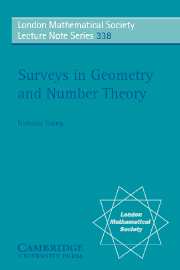Book contents
- Frontmatter
- Contents
- Preface
- Affine embeddings of homogeneous spaces
- Formal groups over local fields: a constructive approach
- Classification problems and mirror duality
- Birational models of del Pezzo fibrations
- Best Diophantine approximations
- Projectively dual varieties of homogeneous spaces
- Equivariant embeddings of homogeneous spaces
- Geometric quantization and algebraic Lagrangian geometry
Geometric quantization and algebraic Lagrangian geometry
Published online by Cambridge University Press: 07 May 2010
- Frontmatter
- Contents
- Preface
- Affine embeddings of homogeneous spaces
- Formal groups over local fields: a constructive approach
- Classification problems and mirror duality
- Birational models of del Pezzo fibrations
- Best Diophantine approximations
- Projectively dual varieties of homogeneous spaces
- Equivariant embeddings of homogeneous spaces
- Geometric quantization and algebraic Lagrangian geometry
Summary
Introduction
The main theme of this survey is the quantization of classical mechanical systems in terms of algebraic geometry. The aim is thus to relate questions of mathematics and theoretical physics. We first recall briefly the main problems and methods which turn us to study the new subject.
Quantization itself is the main problem of theoretical physics. The need to introduce and develop it was dictated by the creators of quantum theory. According to the ‘Copenhagen philosophy’, the physical predictions of a quantum theory must be formulated in terms of classical concepts (the first sentence of Woodhouse; here we quote the beginning of this survey). Thus in addition to the usual structures (Hilbert space, unitary transformations, selfadjoint operators …, see, for example, Landau and Lifschitz) any reasonable quantum theory has to admit an appropriate passage to a classical limit under which quantum observables are transferred to their classical analogues. However, as Dirac pointed out at the beginning of the quantum age, the correspondence between quantum theory and classical theory should be based not just on numerical coincidences taking place in the limit h → ∞, but on an analogy between their mathematical structures. Classical theory does approximate the quantum theory, but it does more – it supplies a framework for some interpretation of quantum theory. Using this idea, we can in general understand a quantization procedure as a correspondence between classical and quantum theories. In this sense, quantization of the classical mechanical systems is a movement in one direction, while taking the quasiclassical limit goes in the opposite direction.
Information
- Type
- Chapter
- Information
- Surveys in Geometry and Number TheoryReports on Contemporary Russian Mathematics, pp. 279 - 318Publisher: Cambridge University PressPrint publication year: 2007
Accessibility standard: Unknown
Why this information is here
This section outlines the accessibility features of this content - including support for screen readers, full keyboard navigation and high-contrast display options. This may not be relevant for you.Accessibility Information
- 13
- Cited by
